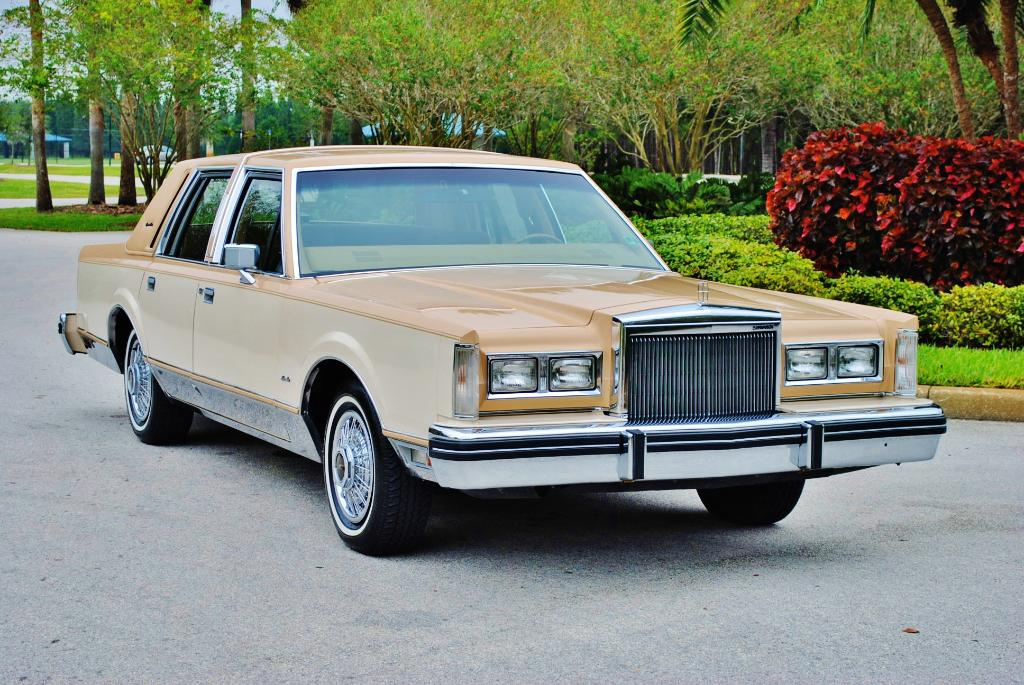With the impending adoption of federal fuel-economy standards (CAFE) making the large cars of the 1970s a potential financial threat to Ford Motor Company, the full-size cars of all of its divisions underwent extensive downsizing for the 1979 model year. For various reasons, delays pushed the release of the downsized Lincoln model lineup into 1980, three years after the downsizing of its Cadillac counterparts.
The downsizing undergone by the 1980 Lincoln and Mark provided Lincoln with the best year-to-year fuel economy improvement (38%) in Ford history. The introduction of a standard overdrive transmission enabled the division to leap its competitors, going from the company with the worst CAFE rating to the most fuel-efficient full-size car sold.
One of the most touted options the 1980 Continental offered was the new digital instrument cluster, which used vacuum fluorescent displays for the vehicle speedometer, odometer, fuel gauge, and temperature gauge. However, the biggest feature was the included "trip computer" that showed the driver "miles to empty" and (based on driver input) an "estimated time of arrival", as well as real-time average fuel economy figures. The digital instrument cluster with the trip computer, along with the engine's new standard electronic fuel injection, 4-speed AOD transmission, power steering and suspension advances, and the new EEC III engine management system allowed the 1980 Lincoln Continental to gain a major technological advantage over its competition; instead of being just a mere redesign and downsize of the 1979 models, the 1980 Continentals would be some of the most advanced vehicles ever sold by Ford up to that point.
This version of the Continental would last only for a single model year. To eliminate saturation of the Lincoln model line, the car was re-released as the Lincoln Town Car for 1981, while the Continental name would move to the midsize segment as an early 1982 model. While not officially announced as the replacement for the Versailles, the 1982 Continental would become the Lincoln competitor for the Cadillac Seville. After the end of its model cycle, the Continental Mark VI was replaced by the Mark VII, a far different vehicle.
Chassis
Central to the redesign was the adoption of the all-new the Ford Panther platform, shared with the Ford LTD and Mercury Marquis. While retaining the body-on-frame layout of its predecessor and using a rear-wheel drive powertrain, the Panther platform made major engineering changes to lower curb weight. In addition, the chassis itself was smaller in several key dimensions. While only approximately 2 inches narrower, the 1980 Continental shed 10 inches of its wheelbase and 14 inches in length. In losing nearly 1000 pounds of curb weight, the 1980 Continental came within 200 pounds of the curb weight of the "compact" Lincoln Versailles.
In its focus on fuel economy, the Panther platform was developed without the use of the 400 or 460 V8s powering full-size Lincoln-Mercurys throughout the 1970s. In their place was the first fuel-injected V8 engine produced by Ford Motor Company. Based on the 302 cubic-inch Windsor V8, the newly christened 129 hp 5.0L V8 (rounded up from its true 4.9L displacement) was the first "metric-displacement" American Ford engine. As an option, a 140 hp carbureted 351 cubic-inch Windsor V8 was available. In place of the C6 3-speed automatic transmission was an all-new 4-speed Automatic Overdrive Transmission (AOD). Developed under the name Ford Integral Overdrive (FIOD), this industry-first transmission featured both a mechanically-engaged overdrive (0.67/1 ratio) fourth gear and third and fourth-gear torque converter lock-up.
The new Panther platform allowed for changes in the new Continental's suspension geometry and many improvements were made to the power steering. With this, and the reduced overall size, the 1980 Lincoln Continental was able to retain the traditional big car ride and feel, while offering a major enhancement to its handling. Compared to the 1980 Continental's GM and Chrysler counterparts and the 1979 Lincoln models, the new car offered more agile maneuvering, as well as a reduced turn diameter by over 8 feet (compared to the 1979 Lincoln Continental).
Body
Although sharing a common platform and powertrain with the Ford LTD and Mercury Marquis, the Lincoln Continental was well differentiated from its counterparts; no visible body panels were common between the three vehicles.
In contrast, the 1980 Continental was positioned as the base model of the Lincoln model line; the Continental Town Car/Town Coupe made its return as the top-trim model. As all Continentals wore padded roofs, Continental Town Cars were largely differentiated by two-tone paint. Lincolns were differentiated from Continental Mark VIs by their exposed headlights and full-width taillamps (instead of a "Continental spare tire trunk"). Two-door Lincolns can be distinguished from Mark VI two-doors with their "notchback" roofline; they share a common wheelbase with four-door Lincolns.








.jfif)




No comments:
Post a Comment